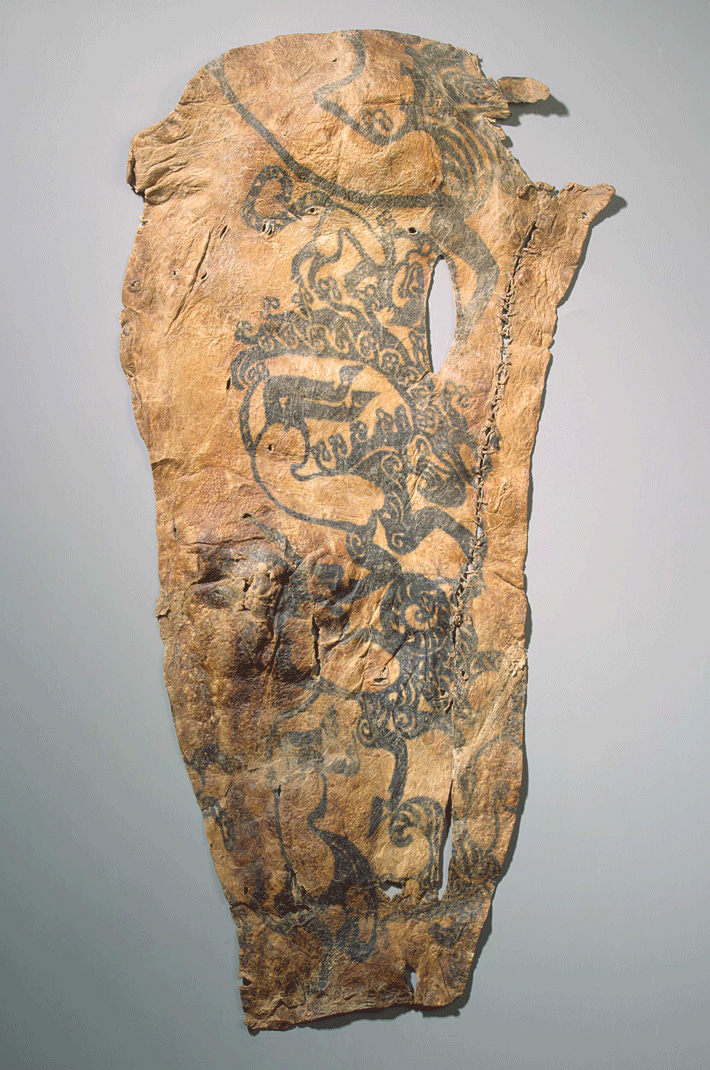Tuesday, July 14, 2020
ST. PETERSBURG, RUSSIA—The Siberian Times reports that scientists at Russia’s State Hermitage Museum have taken a CT scan of a mummified head dated to between the third and fourth centuries A.D. Discovered in 1969 in a burial house made of larch logs in the Oglakhty burial ground, the masked mummy head belongs to the Tashtyk culture of Siberia’s Yenisei River Valley. “The computer scan allowed us to see, so to say, three layers—the layer of the mask, the layer of the face without the mask, and the layer of the skull,” said museum curator Svetlana Pankova. The scan revealed brown hair and a sutured wound beneath the gypsum death mask, which was painted red with black stripes. The scar, which travels from the left eye to the left ear, is thought to have been sewn after death, perhaps to repair a wound so that the mask would fit properly. Pankova said there is also a hole in the left side of the mummy’s skull, which is also thought to have been made after death in order to remove the brain and prepare the body for burial. “Expert analysis shows the hole was made by a series of blows with a chisel type or hammer type tool,” she explained. The scan also revealed the presence of tattoos on the body, the first to be found on a Tashtyk mummy. To read about tattoos adorning mummified members of the Pazyryk culture uncovered in Siberia, go to "Ancient Tattoos: Iron Age Mummy."
PHOTO'S FROM
https://metro.co.uk/2020/07/13/technology-reveals-face-behind-1700-year-old-siberian-death-mask-12983192/?ito=newsnow-feed?ito=cbshare



LOOKS LIKE LEATHER FACE FROM
TEXAS CHAINSAW MASSACRE

Iron Age Mummy
November/December 2013
Culture: Pazyryk
Location: Russia
Date: Fourth to Third centuries B.C.

(The State Hermitage Museum)
Some of the most spectacular tattoos in the ancient world have been found adorning Iron Age mummies unearthed in the Altay Mountains of Siberia. There, a series of tombs dug into permafrost preserved the remains of nobles from a nomadic people today known as the Pazyryk Culture. On the skins of these mummies were intricate tattoos, depicting both mythical and real animals in action: running, stalking victims, or twisting in an S-shape, which scholars call “the pose of agony.”
Archaeologist Sergey Yatsenko of the Russian State University for the Humanities says the animal most commonly found was a monster that took the form of a wild goat with an eagle’s beak and a panther’s tail. This creature appeared on the upper part of the right shoulder of most of the mummies. On the left shoulder, the Pazyryk people sported the depiction of a tiger or a wild ram. A rooster poised for battle was frequently tattooed on noblemen’s forefingers, and a group of goats or rams often marched along their lower legs.
Yatsenko points out that Greek accounts of the period stress that “barbarians” in Eurasia never went nude or even semi-nude in public, so most of these tattoos would probably have never been seen by others. Why endure the long and painful process of getting such dramatic tattoos if they were always covered? “I think they were for magical protection,” says Yatsenko, whose favorite Pazyryk tattoos are abstract designs found on the hands of a man who was probably a shaman. “Those tattoos were probably his spiritual weapons.”
No comments:
Post a Comment